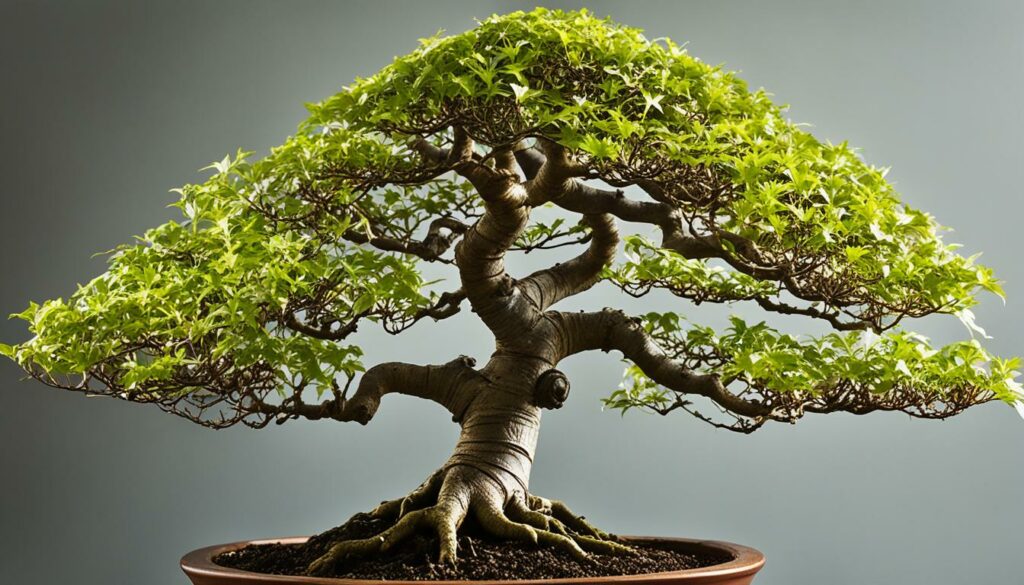If you are looking for a beautiful and adaptable deciduous bonsai, look no further than the Trident Maple (Acer buergerianum). The Trident Maple is a favored bonsai tree species among enthusiasts, thanks to its stunning foliage and suitability for bonsai cultivation. In this comprehensive guide, you will discover the unique characteristics of the Trident Maple, learn how to care for it, and explore different styles to enhance its visual appeal.
Key Takeaways:
- The Trident Maple is a versatile and popular bonsai tree species.
- Trident Maple bonsai requires proper care, including watering, fertilizing, and pruning techniques.
- Choosing the right soil and container is crucial for the growth and development of your bonsai tree.
- Wiring and pruning techniques can be used to shape and style the Trident Maple bonsai.
- The Trident Maple offers various styling options to showcase its unique characteristics, such as formal upright and cascade.
Introduction to the Trident Maple Bonsai
The Trident Maple (Acer buergerianum) is an excellent bonsai species for both novice and experienced enthusiasts. This deciduous tree is sought after for its stunning foliage that transforms from bright green to vibrant oranges and reds during autumn. The Trident Maple is indigenous to East Asia and is also known as Burger’s Maple or three-toothed maple.
The species has been cultivated as bonsai trees for hundreds of years, and their popularity continues to grow due to their adaptability to different climates and soil conditions. The tree is especially favored for its durability, making it an ideal choice for beginner’s bonsai enthusiasts.
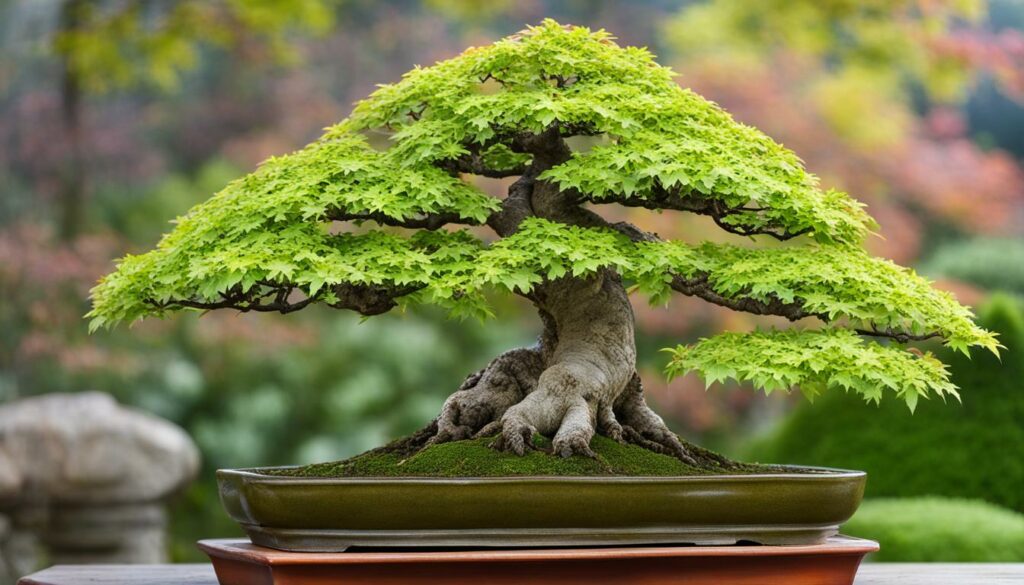
One of the characteristics that make the Trident Maple bonsai stand out is its small five-lobed leaves. These leaves provide a beautiful scale representation of the tree species while also making it easier to prune and shape.
Getting Started with Trident Maple Bonsai Care
When it comes to taking care of your Trident Maple bonsai, proper care is vital for its health and longevity. In this section, we will discuss essential care tips to ensure your bonsai thrives in its environment.
Watering
Water is the source of life for all plants, and your deciduous bonsai is no exception. Water your bonsai when the soil dries out, but avoid over-watering, which can lead to root rot. Use room temperature water and ensure the water drains out of the drainage holes in the container thoroughly.
Fertilizing
Fertilizing your Trident Maple bonsai is crucial to provide essential nutrients for growth and maintenance. Use a balanced fertilizer every two weeks during the growing season and reduce the frequency during winter. Avoid over-fertilizing, which can cause damage to the roots.
Pruning
Pruning is an essential technique to maintain the shape and aesthetic appeal of your Trident Maple bonsai. Regular pruning will encourage healthy growth and prevent overcrowding of branches and leaves. Use wiring techniques to reshape the plant but avoid wiring during the winter.
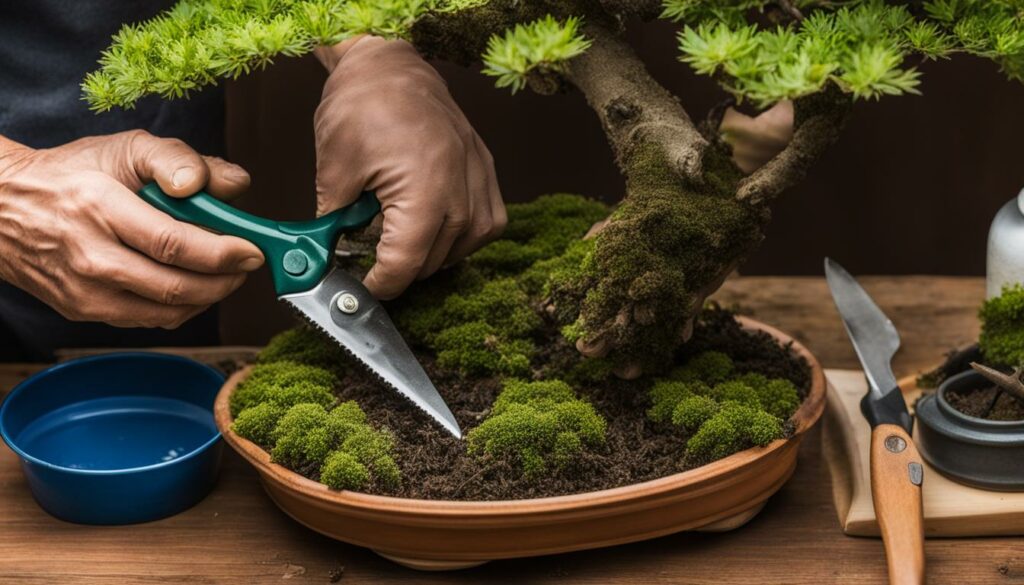
Proper care will help your Trident Maple bonsai thrive, turning it into a visually stunning addition to your bonsai collection.
Choosing the Right Soil and Container for Your Trident Maple Bonsai
Choosing the right soil and container is crucial for the health and growth of your Trident Maple bonsai. To promote optimal growth, the soil should be well-draining, providing adequate moisture retention and oxygen flow. A mixture of akadama, pumice, and lava rock in a ratio of 1:1:1 is ideal for Trident Maple bonsai. Akadama is the primary ingredient and retains the required moisture while allowing air to permeate the soil. Pumice and lava rock, on the other hand, improve drainage and create air pockets vital for root development.
When it comes to container selection, unglazed ceramic containers are preferred as they allow for proper drainage and good aeration of the roots. Plastic containers may be used but ensure that they have adequate drainage holes to avoid waterlogging, which can lead to root rot.
Wiring and Pruning Techniques for Trident Maple Bonsai
Wiring and pruning are essential techniques for shaping and styling Trident Maple bonsai. Proper wiring directs the tree’s growth and allows you to create the desired form. Pruning helps maintain the size and shape of the tree, while also encouraging new growth.
When wiring your Trident Maple, take care to wrap the wire around the trunk and branches gently but firmly. Ensure the wire is at an angle of approximately 45 degrees to the branch to prevent cutting. Leave the wire on for around six months or until the branch has set itself in a new position.
Pruning your bonsai tree involves removing unwanted leaves, buds, and branches. Use sharp, clean tools to make precise cuts and avoid tearing the bark. You can perform maintenance pruning at any time of year, while heavy pruning is best done in spring before new growth occurs.
To ensure your bonsai tree looks balanced and natural, avoid pruning all the branches on one side at once. Instead, alternate sides and maintain some of the tree’s foliage to generate energy for new growth.
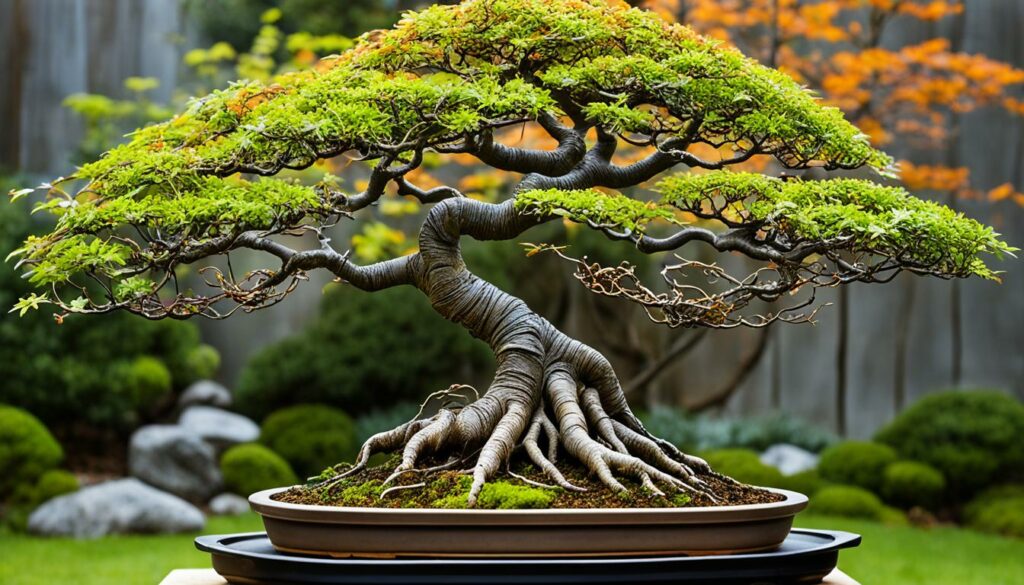
Mastering the art of wiring and pruning can take time, but it will enhance the beauty of your Trident Maple bonsai, creating a visually stunning work of art.
Styling Options for Trident Maple Bonsai
Trident Maple bonsai offers numerous styling options to showcase its unique beauty and characteristics, allowing you to create a truly bespoke bonsai tree that reflects your aesthetic preferences. Below are some popular Trident Maple bonsai styles:
| Style | Description | Image |
|---|---|---|
| Formal Upright | A straight, upright style with a tapered trunk and branches arranged in a tiered, symmetrical pattern. | 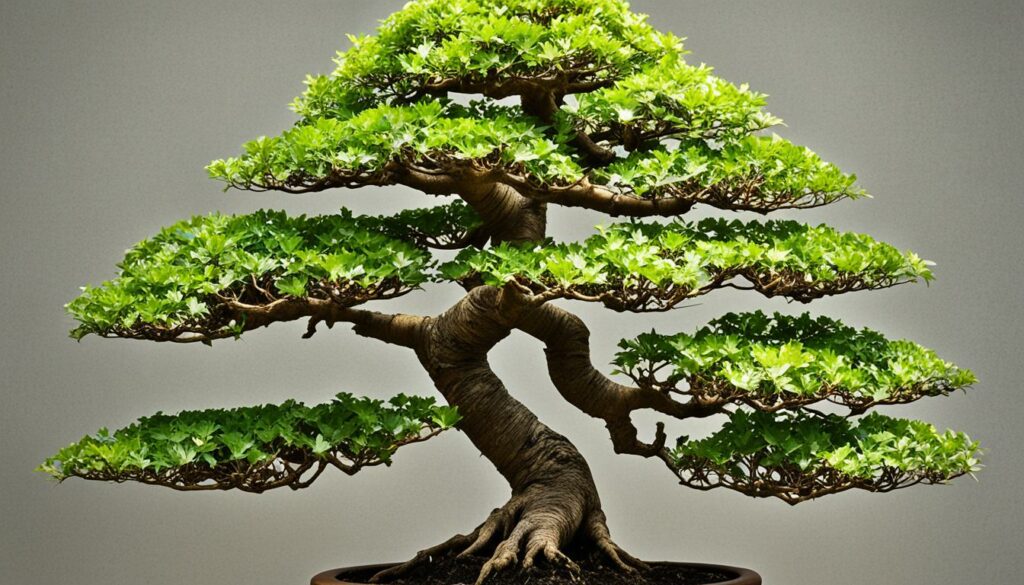 |
| Slanting | A dramatic style with a slanted trunk that angles towards the side, conveying a sense of movement and windswept aesthetic. | 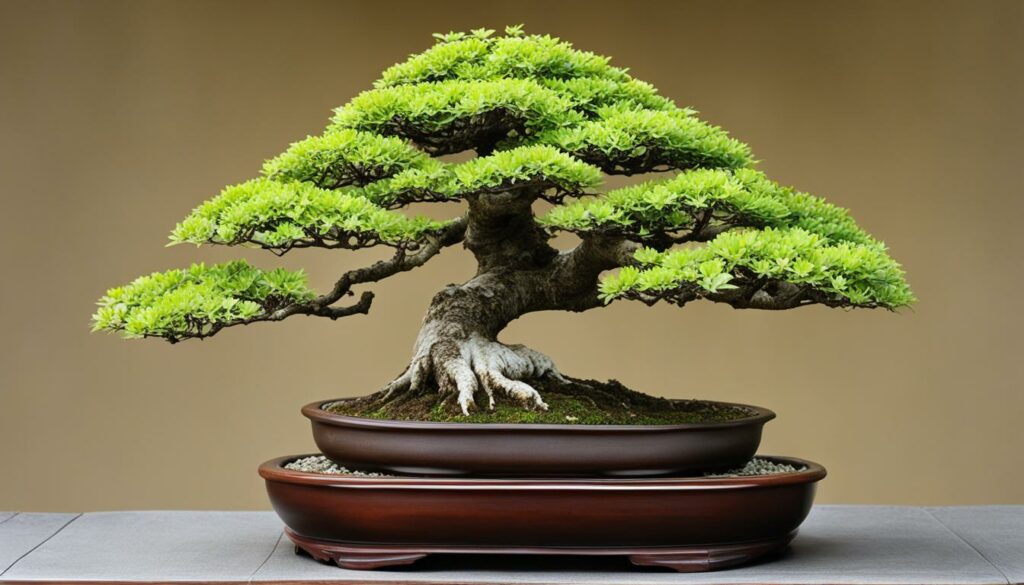 |
| Cascade | A cascading style with branches that hang gracefully over the container’s edge, creating a sense of motion and natural beauty. |
Other styling options include informal upright, broom, windswept, semi-cascade, and literati, among others. Whether you choose to follow a traditional style or create a unique one, remember that the key to a successful Trident Maple bonsai is to maintain its natural beauty and unique characteristics.
Seasonal Care for Trident Maple Bonsai
To ensure the health and wellbeing of your Trident Maple bonsai, it is essential to provide proper care throughout the year. Here are some tips to help you care for your deciduous bonsai during each season:
Spring:
As the weather warms up, your Trident Maple bonsai will start to grow new leaves. During this time, it is important to fertilize your tree every two weeks using a balanced fertilizer. You should also watch for pests such as aphids, spider mites, and scale insects, which can be controlled using insecticidal soap or neem oil.
Summer:
During the hot summer months, your deciduous bonsai will need to be watered frequently to prevent the soil from drying out. You should also provide shaded areas for your bonsai tree, especially during the hottest part of the day. Prune your bonsai regularly to maintain its shape and remove any dead or damaged branches.
Fall:
As the leaves on your Trident Maple bonsai start to change color, reduce the amount of water you provide. This will help the tree prepare for the dormancy period during the winter months. Remove any fallen leaves from the soil and ensure the bonsai is protected from strong winds.
Winter:
During the dormancy period, your bonsai will require less water. Water your Trident Maple bonsai only when the soil feels dry to the touch. Protect your tree from freezing temperatures by bringing it inside or providing a protective cover. Prune your bonsai tree during the winter months to prepare it for the new growth in the spring.
Troubleshooting Common Issues with Trident Maple Bonsai
If you notice any problems with your Trident Maple bonsai, don’t panic. Like any living plant, bonsai trees may experience issues such as pests, diseases, or leaf discoloration. Here are some common problems and troubleshooting tips.
Pests
Pests like aphids, mites, and scale insects can harm your Trident Maple bonsai. Check the leaves and branches regularly for signs of infestation. If you spot any pests, gently wash the leaves and branches with a mixture of water and soap. Alternatively, you can use insecticidal sprays or sticky traps to get rid of the pests.
Diseases
Trident Maple bonsai can also be susceptible to diseases like root rot and powdery mildew. Overwatering and poor air circulation are common causes of these diseases. To prevent these issues, avoid overwatering and make sure your bonsai is placed in an area with good air circulation. If you notice any signs of disease, such as yellow leaves or a cotton-like substance on the leaves, treat your bonsai with a fungicide.
Leaf Discoloration
Discoloration of leaves can indicate a nutrient deficiency, overwatering, or underwatering. Check the soil moisture level and adjust your watering schedule accordingly. If the leaves have yellow or brown spots, it could indicate a nutrient deficiency. Use a balanced fertilizer to provide your bonsai tree with the necessary nutrients.
With proper care and attention, you can keep your Trident Maple bonsai healthy and thriving. Regularly monitor your bonsai tree for any issues and address them promptly using the tips above.
Displaying and Appreciating Your Trident Maple Bonsai
After all the hard work you’ve put into caring for your Trident Maple bonsai, it’s time to show it off! Proper display techniques not only enhance the visual appeal of your bonsai but also promote its health and longevity. Here are some tips for displaying and appreciating your Trident Maple bonsai:
1. Choosing the Right Location
When displaying your bonsai, it’s important to find the right location in your home or garden. Your Trident Maple bonsai needs a spot with plenty of natural light, but avoid placing it in direct sunlight, as this can scorch the leaves. You can also use artificial lighting to supplement natural light and promote growth. Keep your bonsai away from drafts and extreme temperatures, as this can stress your bonsai.
2. Selecting a Display Stand
A display stand accents the unique beauty of your bonsai while also providing stability and support. You can find display stands made from various materials, such as wood, ceramic, and metal. Choose a stand that complements your bonsai’s style and size. If you’re displaying multiple bonsai, consider using a multi-tiered stand to create a visually appealing display.
3. Choosing a Pot
The pot you choose for your Trident Maple bonsai is just as important as the display stand. Bonsai pots come in various sizes, colors, and materials. The pot should be proportionate to the size of your bonsai tree. It’s also essential to choose a pot with adequate drainage to prevent root rot and other issues.
4. Creating a Display
When creating a display for your bonsai, consider the season, colors, and textures of your Trident Maple. You can use ground cover, moss, rocks, and other materials to enhance the visual appeal of your bonsai display. Keep in mind the style of your bonsai, and choose a container and display stand that complement the tree’s overall form and structure.
By following these simple tips, you can showcase the unique beauty of your Trident Maple bonsai and appreciate its natural splendor for years to come.
Conclusion
You have now discovered the beauty and adaptability of the Trident Maple bonsai, a deciduous tree species favored by enthusiasts. By following the care tips outlined in this guide, you can ensure the health and vitality of your bonsai tree, allowing it to thrive in its environment.
Additionally, exploring various styling options, such as the formal upright, slanting, and cascade, will enable you to showcase the unique characteristics of your Trident Maple bonsai while reflecting your aesthetic preferences.
Remember to provide your bonsai with seasonal care, troubleshoot common issues, and display and appreciate its beauty. By embracing the art of bonsai with the versatile Trident Maple, you can create a visually stunning bonsai that will be the centerpiece of your collection.
Thank you for joining us on this journey, and we hope this guide has been informative and helpful in your approach to Trident Maple bonsai care and styling.
FAQ
What is a Trident Maple bonsai?
A Trident Maple bonsai is a miniature version of the Acer buergerianum tree, cultivated and trained in the art of bonsai. It showcases the unique characteristics of the Trident Maple, such as its stunning foliage and adaptability.
How do I care for a Trident Maple bonsai?
Caring for a Trident Maple bonsai involves regular watering, proper fertilization, and pruning to maintain its shape and health. It is important to provide it with adequate sunlight and protect it from extreme temperatures.
What soil should I use for my Trident Maple bonsai?
Ideal soil for Trident Maple bonsai should have good drainage and moisture retention. A mixture of Akadama, pumice, and lava rock is often used to create a well-draining soil that promotes healthy root growth.
How often should I water my Trident Maple bonsai?
The frequency of watering your Trident Maple bonsai depends on various factors, such as the climate, time of year, and size of the bonsai. As a general guideline, you should check the moisture level in the soil regularly and water thoroughly when the top inch of soil feels dry.
When should I prune my Trident Maple bonsai?
The best time to prune your Trident Maple bonsai is during late winter or early spring, before the new growth emerges. This allows the tree to heal quickly and minimizes stress on the bonsai.
Can I wire my Trident Maple bonsai to create different shapes?
Yes, wiring is a common technique used to shape and style Trident Maple bonsai. It allows you to create elegant curves and bends in the branches, giving your bonsai a more artistic form. However, care should be taken not to leave the wires on for too long to avoid wire scars on the branches.
What are the different styling options for Trident Maple bonsai?
Trident Maple bonsai can be styled in various forms, including but not limited to formal upright, slanting, and cascade styles. Each style showcases different aspects of the tree’s natural growth patterns and allows for artistic expression.
How do I display my Trident Maple bonsai?
Displaying your Trident Maple bonsai requires choosing an appropriate bonsai display stand or table, considering factors such as size, aesthetic appeal, and stability. It is important to place the bonsai in an area where it receives adequate sunlight and where it can be admired and appreciated.
What are some common issues with Trident Maple bonsai, and how can I address them?
Common issues with Trident Maple bonsai include pests, diseases, and leaf discoloration. To address them, regularly inspect your bonsai for any signs of pests or diseases, and take appropriate action promptly. Providing proper care, such as providing the right amount of water, sunlight, and fertility, can also help prevent or mitigate these issues.
How long does it take for a Trident Maple bonsai to mature?
The time it takes for a Trident Maple bonsai to mature depends on various factors, including the initial size of the bonsai, the desired final size, and the care provided. On average, it may take several years to a decade or more for a Trident Maple bonsai to develop the desired maturity and aesthetic appeal.
